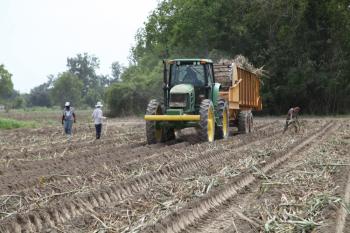
PLANTING CANE is one of the farming tasks that still requires manual labor despite great strides in agricultural technology. Nowadays that labor has to come from Mexico and beyond with a government guest worker program that puts a load of extra paperwork on growers.
No easy task to find & keep farm labor
In the 1960s, a Louisiana sugarcane farmer could only manage a 400-acre farm. Today, that same sugarcane farmer can effectively cultivate 2,000 acres or more. With improvements in transportation, manufacturing, distribution and computers, the American farmer provides American families with the lowest food costs in the world.
But there are some jobs on the farm that may never change. Maybe someday machines will efficiently pick strawberries, plant cane or peel crawfish but until then, finding the labor to do seasonal jobs will remain a challenge for American farmers.
It is difficult for the crawfish plant owner, the strawberry farmer and the sugarcane producer to find the labor necessary to produce food at competitive prices that allows them to make a profit.
Because of technology, the American farmer can manage with fewer full-time laborers than ever before, but problems arise when the producer needs a larger workforce to do a particular job during a particular season.
For the sugarcane farmer, that time comes in the late summer when he’ll need about 10 temporary workers to help him plant cane. As the season progresses, he may only need five additional experienced tractor operators to work seven days a week until harvest is done. The sugarcane miller will also need boilers and other laborers for only 100 days to process cane juice into raw sugar.
The farmer and miller would like nothing more than to hire someone local – an American – to help him with the job. However, we have so many opportunities in this country that much of the available labor is steadily working in the oil field, behind a truck wheel or in a Walmart warehouse.
The reality is the Louisiana farmer relies on temporary, seasonal labor, mostly from Mexico and other countries where economic opportunities are not as abundant as in the United States.
The federal government’s H2-A labor program allows a farmer to recruit guest workers from other countries to come to his farm for 30, 60 or 90 days to do a seasonal job.
The farmer must provide the correct number of portable toilets in the field for his pickers (one for every 20 workers. If he has 21 workers, then he better provide two outdoor johns or risk a $1,500 fine).
He must provide guest labor with safe transportation with working seat belts to shopping centers and medical care or risk a $1,500 fine. He must provide adequate, clean housing for his workers. He must also keep meticulous labor records and do it all perfectly according to federal regulations or be subject to fines and penalties.
The majority of the sugarcane industry’s guest workers return to the United States and work year after year in the Sugar Belt, but their work visas must be processed every year.
Among other reforms, the Louisiana sugarcane industry supports a pre-processing system that will be good for five years. If our guest workers compile a positive work history during their employment and have no legal issues in the U.S. or in their native country, then our farmers and millers should be allowed to bring those workers back into the country for unfilled job vacancies to work without costly and unnecessary delays.
It all boils down to this: do we want American farmers to produce our food using foreign workers or do we want foreign farmers producing food for Americans? I’ll take American every time.
Jim Simon is general manager of the American Sugar Cane League.
- Log in to post comments
